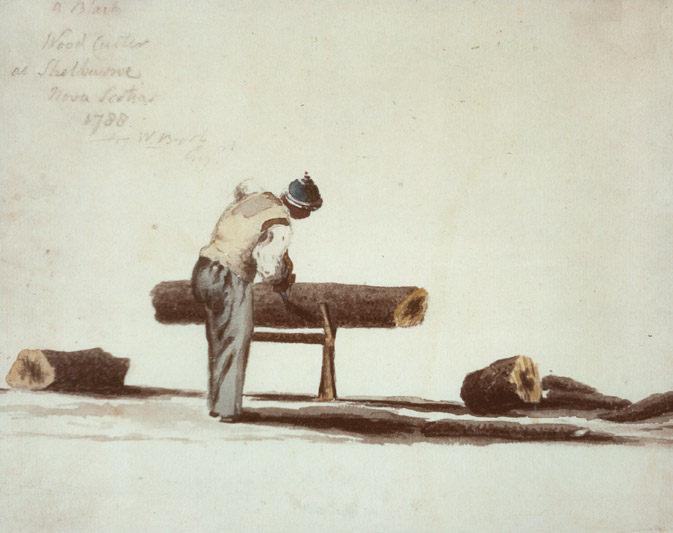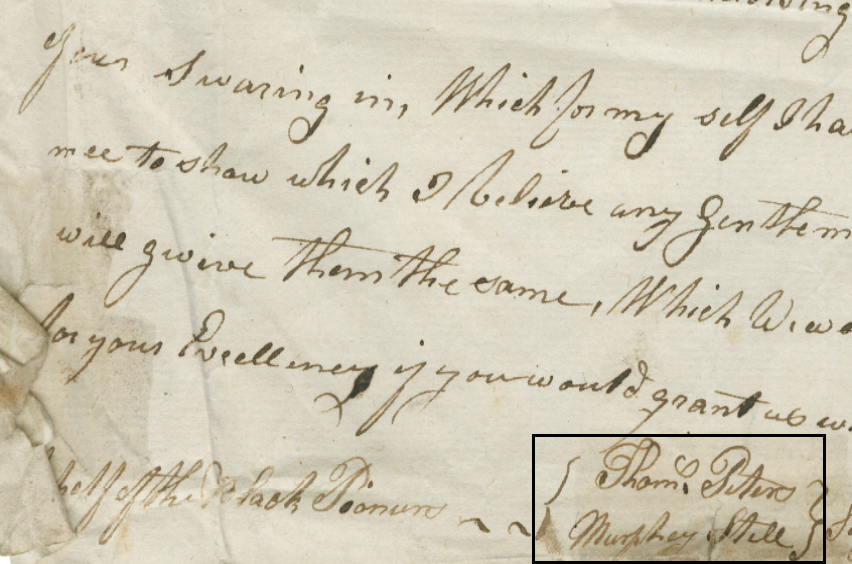Steele, Murphy
b. 1749-?
See also: Thomas Peters, Black Loyalist and African Nationalist, The Black Pioneers Loyalist Company on ANCHOR
 Murphy Steele was a Black Loyalist during the American Revolution. Steele was also a Sergeant in the Black Pioneers military unit.
Murphy Steele was a Black Loyalist during the American Revolution. Steele was also a Sergeant in the Black Pioneers military unit.
Throughout historical records, Steele’s surname has several variations. They include Stiel, Steel, and Still. Murphy’s surname was recorded in the British government’s Book of Negroes ship ledgers as Steele.
Due to his enslavement, many details of Steele's life before joining the Black Pioneers in 1776 are unknown. However, Steele’s birth year can be inferred from the information documented in the Book of Negroes. According to the testament, he joined the Pioneers in 1776 around the age of twenty-seven after fleeing enslavement. This places his birth year around 1749. Steele reported that he fled from an enslaver named Stephen Daniel in Wilmington, North Carolina.
According to primary records of Brunswick and New Hanover Counties, Stephen Daniel was a planter in the Cape Fear River region of North Carolina. Between 1760 and 1780, Daniel was documented in New Hanover and Brunswick Counties. Records further indicate that Daniel lived in Wilmington and regularly conducted business in Saint Phillip's Parish. Daniel also served as a Saint Phillip's Parish clerk and regularly bought and sold enslaved people in both counties. He also published at least two recapturement notices and runaway slave ads between 1800 and 1810. A 1772 tax list of Brunswick County identified Daniel as the enslaver of four Black men and four Black women. One of the men enslaved by Daniel was likely Steele, as he would have been twenty-three years old at the time of the tax audit, the same age as one of the men listed as enslaved by Daniel.
The Revolutionary War also began during Steele’s enslavement to Daniel. On February 9, 1776, the British sloop Cruizer moved up the Cape Fear River to bomb Wilmington and the city was evacuated. More British ships soon arrived from Boston under the command of Sir Henry Clinton. As British ships attacked the city, riverside homes, and plantations, many enslaved people were able to escape to British lines. There, the British monarchy promised freedom to any enslaved person or indentured servant who was “able and willing to bear arms” in support of Britain.
In 1776, at the age of 27, Steele was one of approximately 71 freedom-seeking enslaved people from the Cape Fear River region who joined British forces. Steele was a member of the Black Pioneers, the only Black provincial unit of the British military established by Henry Clinton. The Black Pioneers completed tasks like building, fortification, ditch digging, cooking, cleaning, and more to support routine military operations. They were compensated in the same way as other British and provincial troops, but the Black Pioneers were not armed and did not participate in combat. Steele served as a Sergeant in the Black Pioneers during the war. The company traveled with British forces throughout North America and worked in Loyalist strongholds like Charleston, Boston, and New York.
 Little formal documentation of Steele during the war exists aside from his rank as a Sergeant. However, on August 16, 1781, Steele had a dream or vision that gained the attention of British commanding officers. According to a deposition offered by Steele, he heard “a disembodied voice” that commanded him to deliver a message to Clinton. Steele insisted that Clinton tell General George Washington to surrender to the British Army and if Washington did not surrender, he and the American people would experience the wrath of God. Steele foresaw that “Blacks in America would rise up against Washington’s forces…For…the Lord would be on their side…” British commanding officers dismissed the claims of Steele and his vision.
Little formal documentation of Steele during the war exists aside from his rank as a Sergeant. However, on August 16, 1781, Steele had a dream or vision that gained the attention of British commanding officers. According to a deposition offered by Steele, he heard “a disembodied voice” that commanded him to deliver a message to Clinton. Steele insisted that Clinton tell General George Washington to surrender to the British Army and if Washington did not surrender, he and the American people would experience the wrath of God. Steele foresaw that “Blacks in America would rise up against Washington’s forces…For…the Lord would be on their side…” British commanding officers dismissed the claims of Steele and his vision.
Following their defeat in the war, the British began evacuating the United States. Approximately 3,000 Black Loyalists and others left New York City for British Canada. Steele’s evacuation was part of a group of sixty-seven Black Pioneers, servants, and manual laborers for the King’s army. Sometime before leaving, Steele married. His wife was most likely Mary, another member of the Black Pioneers. She is documented in the Book of Negroes as “twenty-five year old, Mary Steel.” She was also a Black Loyalist, having fled from an enslaver named Charles Cannon in Portsmouth, Virginia. Steele was boarded onto the ship Joseph on November 9, 1783. He, Mary, and other Black Pioneers like Thomas Peters were sent to nearby Nova Scotia, Canada, then a British colony.
Strong winds and weather blew the Joseph off course on its way to Nova Scotia. This event forced the ship and its passengers to dock at the British colony of Bermuda for the winter. The Joseph and its passengers, including Steele, reached Annapolis Royal, Nova Scotia on May 25, 1784.
Conditions in Nova Scotia were harsh for Loyalists but especially for Black Loyalists. Initially, the British government promised food, land, tools, and free travel to Loyalists evacuated from New York when they arrived in Nova Scotia. The first year of aid was delayed and then insufficient once delivered. The British colonial government also placed Black Loyalists like Murphy Steele, Mary Steel, and Thomas Peters into racially segregated villages with rocky, hard land not suited for growing crops.
After his arrival in Nova Scotia, Steele settled in a segregated suburb of Annapolis Royal called Digby. Steele and Thomas Peters became well-known members and activists for Black land rights in the community. While white Loyalists in Nova Scotia often received large land grants of about 100 acres, Black Loyalists received little to no land. Steele and Peters issued a petition "on behalf of the Black Pioneers" to Governor John Parr on August 20, 1784. It enumerated the service of Black Loyalist veterans like Steele and Peters to the British monarchy. It also referenced promises made to Black Loyalists by British royal decrees such as Lord Dunmore’s Proclamation (1775) and the Philipsburg Proclamation (1779). In response to the petition, the British colonial government granted land to some Black Loyalists. In 1785, those including Steele “received a one acre Loyalist Land Grant in Digby Township, Annapolis County, Nova Scotia.”
Steele’s life after the petition advocating on behalf of Black Pioneers is not documented. Details like his death date, other places of residence, and other members of his family are not known.
References
Berlin, Ira. Slavery in New York. New York: New Press, distributed by W.W. Norton, 2005. https://archive.org/details/slaveryinnewyork00berl/page/92/mode/2up?view=theater&q=murphy+stiel (accessed July 25, 2024).
“Black Loyalists Heritage Site.” Black Loyalist Heritage Center. https://blackloyalist.com/birchtowns-historical-site-2/ (accessed July 25, 2024).
“Black Pioneers: Word of the Lord.” The On-Line Institute for Advanced Loyalist Studies. December 15, 1999. https://www.royalprovincial.com/military/rhist/blkpion/blklet4.htm (accessed July 25, 2024).
“Book of Negroes.” African Nova Scotians in the Age of Slavery and Abolition. Nova Scotia Archives. July 2024. https://archives.novascotia.ca/africanns/book-of-negroes/ (accessed July 25, 2024).
Bunnell, Paul J. “Black Loyalists of Digby Nova Scotia.” Digby County, Nova Scotia GenWeb. https://sites.rootsweb.com/~nsdigby/lists/article2.htm (accessed July 25, 2024).
Burch, Wanda. “Book Discussions Focusing on Slavery Set.” New York Almanack. February 6, 2013. https://www.newyorkalmanack.com/2013/02/book-discussions-focusing-on-slavery-set/ (accessed July 25, 2024).
de Bruin, Tabitha. "Black Pioneers of the American Revolution." The Canadian Encyclopedia. Historica Canada. March 25, 2024. https://www.thecanadianencyclopedia.ca/en/article/black-pioneers-of-the-american-revolution (accessed July 25, 2024).
Hodges, Graham Russell. Root & Branch: African Americans in New York and East Jersey, 1613-1863. Chapel Hill, NC: University of North Carolina Press, 1999. https://archive.org/details/rootbranchafrica0000hodg/page/160/mode/2up?view=theater&q=murphy+stiel (accessed July 25, 2024).
“Loyalist Directory – Details: Murphy Steele.” The United Empire Loyalists' Association of Canada. September 5, 2022. https://uelac.ca/loyalist-directory/detail/?wpda_search_column_id=11021 (accessed July 25, 2024).
“Loyalist Trails 2008-24.” The United Empire Loyalists' Association of Canada. June 15, 2008. https://uelac.ca/loyalist-trails/loyalist-trails-2008-24/ (accessed July 25, 2024).
“Loyalist Trails 2013-20.” The United Empire Loyalists' Association of Canada. May 19, 2013. https://uelac.ca/loyalist-trails/loyalist-trails-2013-20/ (accessed July 25, 2024).
“Petition on behalf of the Black Pioneers.” Looking Back, Moving Forward: Documenting the Heritage of African Nova Scotians. Nova Scotia Archives. August 20, 1784. https://archives.novascotia.ca/african-heritage/archives/?ID=19 (accessed July 25, 2024).
“VII: The Military.” Loyalists of the Maritimes. The United Empire Loyalists' Association of Canada. https://www.uelac.org/education/MaritimesResource/Maritimes-07.pdf (accessed July 25, 2024).
Wilson, Ellen Gibson. The Loyal Blacks. New York: Capricorn Books. 1976.
Image Credits:
Booth, William. A black wood cutter at Shelburne, Nova Scotia. Watercolor sketch. 1788. Nova Scotia Archives, National Archives of Canada. C-040162 W.H. Coverdale Collection of Canadiana. https://archives.novascotia.ca/africanns/archives/?ID=39 (accessed August 20, 2024).
Peters, Thomas, and Murphy Steel. "Petition on behalf of the Black Pioneers." August 20, 1784. Commissioner of Public Records, Nova Scotia Archives. RG 1, volume 359, number 65. https://archives.novascotia.ca/african-heritage/archives/?ID=19&Page=200402038 (accessed August 20, 2024).
21 August 2024 | Kassa, Kemisa